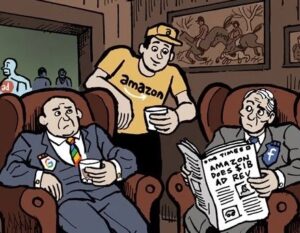Procter & Gamble has a reputation for putting its partners through the wringer – and sometimes out of business.
Some ad tech CEOs are hopping mad about it. “The death of AudienceScience is on P&G’s doorstep,” said one ad tech chief exec.
AudienceScience, P&G’s longtime buying platform, was forced to close its doors last week, less than a month after losing the account it had held for the better part of a decade.
Others have already rushed in, including demand-side platforms The Trade Desk and, as AdExchanger reported on Tuesday, MediaMath. The duo will work alongside Neustar, P&G’s freshly picked data management platform.
P&G’s new partners already have a leg up. They’re allowed to be public about the relationship, a strict no-no for AudienceScience, and they can even work with other CPGs.
The terms of AudienceScience’s contract were clearly less than ideal, but AudienceScience isn’t purely a victim.
“It sucks,” another ad tech exec said, “but putting all of your eggs in one basket is a dangerous game. You can’t fault P&G. In our world, there is no loyalty and you’re only as good as what you did yesterday.”
But many said P&G bears responsibility for the fate that befell AudienceScience. It’s hard to diversify when, as one former AudienceScience employee put it, “80% to 90% of your mental energy is going toward solving P&G problems.”
From P&G’s perspective, it selects its partners for “mutual value creation,” said P&G spokeswoman Tressie Rose.
“Our relationship with all partners centers around creating value together,” she said. “When it’s done right, both P&G and our partners grow and create value.”
AdExchanger asked nine ad tech CEOs to anonymously answer this question:
“Knowing what you do about how the AudienceScience story ended, would you pitch P&G for its business?”
Their responses follow.
Hell no
“I wouldn’t pitch P&G even if they told me they were going to spend $100 billion with my company because I wouldn’t let them dictate my road map or services. They just sent a note to the whole ecosystem that says, ‘We don’t give a crap about you, your investors or your employees.’”
Only if you want to be treated like a commodity
“P&G treats its technology providers like they treat shampoo manufacturers in China – it’s a procurement mentality. There are clearly a lot of partners in the ecosystem and maybe too many in the supply chain. But if you’re a single source to the largest buyer in the world, there should be some commitment that you’re building a business together.”
Be careful what you wish for
“What happened here is a very common pitfall of technology businesses. You win the whale, the huge client, and then they absorb all of your attention, focus and effort. Unfortunately, for reasons that probably made sense at the time, the commercial relationship is suboptimal and the business is never able to grow, pivot or extend beyond that anchor customer.
“But anyone who says, ‘I’d never work with them’ is talking rubbish. Any company worth its salt in this industry has to go after that opportunity. They just have to do it with their eyes open.”
It’s P&G’s prerogative
“P&G likes to throw its weight around, but I don’t mind what they’re doing. I like that they’re pushing the envelope to get the industry aligned around a standard, to bring a method to the madness in the industry. They aren’t doing a disservice to the ad tech ecosystem.”
Know what you’re getting into
“With any big strategic account, you always make a trade-off between having to do custom stuff in return for the business. That’s the risk. There are always pros and cons with any big, strategic account, and anyone who goes into one has to know that they’re probably not going to make a ton of money and they’re going to be pulled into a ton of custom development.”
Diversify or die
“As a CEO, I’d be extremely worried if the majority of my business was with one client and I’d make sure to do whatever I possibly could to diversify and also make sure I understand that client’s needs. I’m not saying it would have been easy to do it differently, but AudienceScience got themselves into a tight situation with no security where P&G was able to say, ‘No.’ It’s a precarious position that I’d never want to be in.”
Slow motion crash
“How much heads-up did AudienceScience get from P&G? Was P&G leading them on? I can’t believe that happened. It’s never happened in my experience of business that there’s no sign from the client or that a client is deliberately trying to put you out of business. There are always signs. Just the fact that it was a fraught relationship should have been a sign.”
P&G has its own problems
“I would welcome P&G as a customer. That said, P&G demonstrated in their operation of the Hawkeye project why there needs to be a thoroughgoing change in the marketing leadership there. The ‘group think’ is killing them and now it’s killed one of their captive vendors. Even their new selection of programmatic partners was a closed and incomplete process in more than one observer’s view. The new head of media, Gerry D’Angelo, should be a healthy change bringing outside points of view.”
Who’re you kidding? It’s P&G.
“You always have to pitch P&G whether you want to or not. You take what you can get, and that’s true for any company and for both sides. There’s no loyalty. P&G has crazy amounts of money to spend and anyone would be psyched to get some of it. But until you’re actually owned by them, don’t expect to be there forever.”













